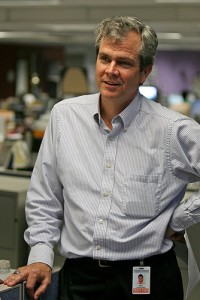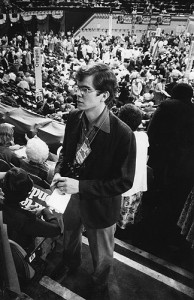
When Edward J. “Ned” Popkins Jr. completed the journalism program in the College of Liberal Arts and Sciences in 1977, there was no Internet, no 24/7 news cycle, and no hint that daily newspapers might be fighting for their survival 30 years later.
In fact, his first job was as a proofreader for The Bulletin in Norwich, Conn., a paper that still exists, though the position of proofreader was even back then all but extinct.
Today, even copy editors are scarce, and Popkins notes that news stories that were once scrutinized by four or five people before appearing in the paper are now sent directly to the Web by reporters within minutes of their being written.
“I never would have guessed that one day newspapers wouldn’t have copy editors. In the ‘old days’ there were a minimum of three people, and often four or five, who looked at a story before publication. There was the assignment editor, the copy editor, and the layout editor – who read at least part of the story – and if the story was important, one or two senior editors. Now a lot of reporters’ work goes straight onto the Web with no editing,” says Popkins, now the business editor of the Orlando (Fla.) Sentinel.
The Sentinel, owned by Chicago-based The Tribune Co., has a weekday circulation of 172,000 and a Sunday circulation of 280,000, as well as the region’s most-used news website.
“In the interest of speed, stories go straight onto the Web,” Popkins says. “As an editor, I read it later and an edited version of the story ‘magically’ takes its place on the Web.”
Popkins, who grew up in Ridgefield, Conn., is not worried about the future of the news business, however. He’s confident that the public will eventually figure out which news sources are reliable and seek them out.
“The revenue model of newspapers [where much of the cost of the newspaper was covered by advertising, which filled roughly half the paper] has been undermined by the Internet,” he says. “So now we are in this awkward period where news is moving from print to the Web, but without the same revenue.”
At the moment, the best way to read a newspaper online is to use an iPad or similar device. But Popkins expects that will change, as even newer technology is developed. “There is no doubt that newsprint is on its way to becoming a niche. But once people fully understand the new technology, they will decide which Internet news sources are good and which are bad and eventually they will even pay for it.”
Popkins, who also worked in Connecticut at the Journal Inquirer in Manchester as a reporter and editor for six years, was recruited by the Dallas Times Herald in 1983, where he worked on a business-news desk for the first time. One of his bosses took a job at the Sentinel, however, and asked him to come for an interview there, with a view to doing copy editing and layout.
“I initially turned it down. Florida was back near the ocean, but it was the other end of the Eastern Seaboard from Connecticut,” he says. But the editor persuaded him to fly in for an interview, suggesting it was, at the very least, a free trip to Orlando. And by the time he left, he had been offered a job as assistant business editor.
“Disney’s Magic Kingdom, Epcot, and SeaWorld were the three big draws then, and there was a huge building boom on,” he says. “Florida was growing. It’s a large state, and there was a real sense of competition among the newspapers then.”
The Miami Herald had just started a Monday business tabloid, and Orlando wanted to do the same thing, he says.
He and his wife, Marianne McClain Popkins, CLAS ’77, settled in Florida. She is manager of a respite-care center in Orlando, and they have three sons, Taylor, John, and Duncan.
The Business of News

Popkins says working the business news desk appeals to him because he is a quantitative thinker. “I really am a numbers guy – at least I can calculate percentage increases correctly, which is amazingly hard for most journalists,” he jokes. “The thing I like most in journalism is explaining complicated things in a simple matter. For example, what should you pay attention to on your 401(k) retirement statement so you don’t end up eating dog food in retirement? The topic of the story might seem like it could be boring, but it’s important, and you have to explain it in a simple and interesting way, since it is in the best interest of our readers.”
Popkins, an Eagle Scout and Boy Scout leader for 21 years, has also supervised coverage of two presidential campaigns, as well as national, foreign, health, and environmental news.
“Back in the ’80s, we had three reporters in Washington, two foreign correspondents, a reporter in Atlanta to cover the Southeast region, and I oversaw the paper’s space and NASA coverage – we had two people at the Kennedy Space Center.”
Since then, the paper’s newsroom staff has shrunk from a high of 360 to about 160 people, and as a result is sharing more news copy with other Tribune properties and even with other Florida papers, while focusing more on local coverage.
Popkins, who graduated from UConn with a bachelor’s degree in Honors English (journalism was a program, but not a major at that time), is working on an online master’s degree from the University of Missouri journalism program. He hopes the future is more of the same.
“I really enjoy working with reporters and helping them shape their coverage. I like that even more than doing the reporting myself,” he says. An introvert by nature, he found journalism a “great way to be thrust into situations an introvert would never naturally go into. I have to approach people, ask uncomfortable questions, and deal with the public on a daily basis.”
So as the news business evolves, with people consulting their cell phones and computer tablets for news and getting used to digesting information in 140-character “tweets,” Popkins intends to continue evolving. And while he has thought about teaching journalism, for now, he doesn’t plan to leave the business.
“I have decided that journalism is a calling. It is not a job but a calling,” he says. “And I enjoy doing what I’m doing.”


